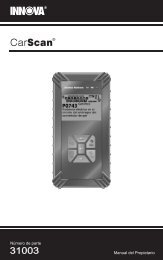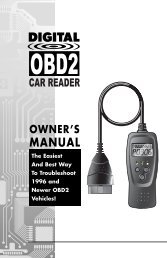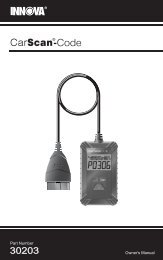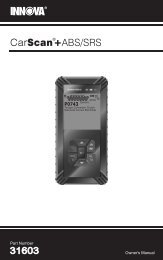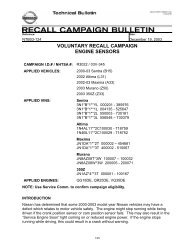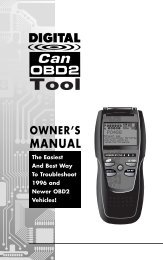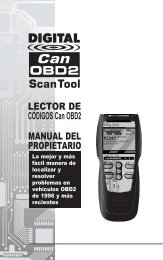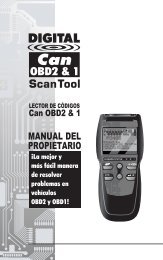Untitled - Innova
Untitled - Innova
Untitled - Innova
You also want an ePaper? Increase the reach of your titles
YUMPU automatically turns print PDFs into web optimized ePapers that Google loves.
Onboard Diagnostics<br />
OBD2 MONITORS<br />
Fuel System Monitor - This Monitor uses a Fuel System<br />
Correction program, called Fuel Trim, inside the on-board<br />
computer. Fuel Trim is a set of positive and negative values that<br />
represent adding or subtracting fuel from the engine. This program is<br />
used to correct for a lean (too much air/not enough fuel) or rich (too<br />
much fuel/not enough air) air-fuel mixture. The program is designed to<br />
add or subtract fuel, as needed, up to a certain percent. If the correction<br />
needed is too large and exceeds the time and percent allowed by the<br />
program, a fault is indicated by the computer.<br />
The Fuel System Monitor is supported by both “spark ignition” vehicles<br />
and “compression ignition” vehicles. The Fuel System Monitor may be a<br />
“One-Trip” or “Two-Trip” Monitor, depending on the severity of the<br />
problem.<br />
Misfire Monitor - This Monitor continuously checks for engine misfires.<br />
A misfire occurs when the air-fuel mixture in the cylinder does not ignite.<br />
The misfire Monitor uses changes in crankshaft speed to sense an engine<br />
misfire. When a cylinder misfires, it no longer contributes to the speed of the<br />
engine, and engine speed decreases each time the affected cylinder(s) misfire.<br />
The misfire Monitor is designed to sense engine speed fluctuations and<br />
determine from which cylinder(s) the misfire is coming, as well as how bad the<br />
misfire is. There are three types of engine misfires, Types 1, 2, and 3.<br />
- Type 1 and Type 3 misfires are two-trip monitor faults. If a fault is sensed<br />
on the first trip, the computer temporarily saves the fault in its memory as<br />
a Pending Code. The MIL is not commanded on at this time. If the fault is<br />
found again on the second trip, under similar conditions of engine speed,<br />
load and temperature, the computer commands the MIL “On,” and the<br />
code is saved in its long term memory.<br />
- Type 2 misfires are the most severe type of misfire. When a Type 2<br />
misfire is sensed on the first trip, the computer commands the MIL to<br />
light when the misfire is sensed. If the computer determines that a<br />
Type 2 misfire is severe , and may cause catalytic converter damage,<br />
it commands the MIL to “flash” once per second as soon as the<br />
misfire is sensed. When the misfire is no longer present, the MIL<br />
reverts to steady “On” condition.<br />
The Misfire Monitor is supported by both “spark ignition” vehicles and<br />
“compression ignition” vehicles.<br />
Catalyst Monitor - The catalytic converter is a device that is<br />
installed downstream of the exhaust manifold. It helps to oxidize<br />
(burn) the unburned fuel (hydrocarbons) and partially burned fuel<br />
(carbon monoxide) left over from the combustion process. To<br />
accomplish this, heat and catalyst materials inside the converter react<br />
with the exhaust gases to burn the remaining fuel. Some materials<br />
inside the catalytic converter also have the ability to store oxygen, and<br />
release it as needed to oxidize hydrocarbons and carbon monoxide. In<br />
the process, it reduces vehicle emissions by converting the polluting<br />
gases into carbon dioxide and water.<br />
The computer checks the efficiency of the catalytic converter by<br />
monitoring the oxygen sensors used by the system. One sensor is located<br />
before (upstream of) the converter; the other is located after (downstream<br />
of) the converter. If the catalytic converter loses its ability to store oxygen,<br />
OBD2 21




